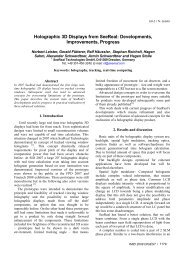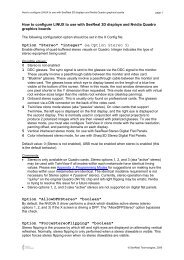Capabilities of diffractive optical elements for real ... - ResearchGate
Capabilities of diffractive optical elements for real ... - ResearchGate
Capabilities of diffractive optical elements for real ... - ResearchGate
You also want an ePaper? Increase the reach of your titles
YUMPU automatically turns print PDFs into web optimized ePapers that Google loves.
110.90.90.80.8Diffraction efficiency η0.70.60.50.40.30.2q = 7q = m = 6q = 5Diffraction efficiency η0.70.60.50.40.30.2q = 7q = m = 6q = 50.10.10400 450 500 550 600 650 700Illumination wavelength λ [nm]0400 450 500 550 600 650 700Illumination wavelength λ [nm](a) Mirror-type(b) Lens-type (acrylate)Figure 3. Diffraction efficiency over the wavelength <strong>for</strong> a multi-order DOE with m = 6 <strong>for</strong> λ 0 = 525 nm. The marginalshift <strong>of</strong> the sinc-functions <strong>for</strong> blue and red wavelengths in (b) is due to material dispersion n(λ). The blaze depth isassumed to be ideal (µ = 1).Optical per<strong>for</strong>mance. The <strong>optical</strong> per<strong>for</strong>mance <strong>of</strong> <strong>diffractive</strong> <strong>optical</strong> <strong>elements</strong> strongly depends on how accuratethe operation corresponds to the ideal situation which the DOE is designed <strong>for</strong>. This applies to bothvariations in the <strong>optical</strong> setup (operation wavelength, alignment), as well as minor fabrication inaccuracies (pr<strong>of</strong>iledepth, pattern distortion) <strong>of</strong> the DOE itself. Apart from alignment errors, which can be avoided by a carefuladjustment, a wavelength change will have an impact on the diffraction efficiency and the phase reconstruction.To address these influences a parameter α was established 11α = λ [ ]0 n(λ) − 1. (6)λ n(λ 0 ) − 1Pr<strong>of</strong>ile depth scaling errors will also influence the diffraction efficiency. In case <strong>of</strong> a constant pr<strong>of</strong>ile depth errorthis can be addressed by introducing a parameter 6 µ = t′t , (7)with t as the nominal and t ′ as the actual pr<strong>of</strong>ile depth. With the parameters α and µ the scalar diffractionefficiency <strong>of</strong> a multi-order DOE <strong>for</strong> the qth diffraction order is then given byη q = sinc 2 (αµm − q) . (8)If the argument <strong>of</strong> the sinc-function equals to zero, the diffraction efficiency will have a maximum. Fig. 3shows the diffraction efficiency vs. wavelength <strong>of</strong> a ’5/6/7’ multi-order DOE designed <strong>for</strong> λ 0 = 525 nm and m = 6.As it can be seen in Fig. 3(a) besides the green efficiency peak there are further maxima at the blaze-matchedwavelengths <strong>of</strong> 450 nm (q = 7) and 630 nm (q = 5). To illustrate the minor influence <strong>of</strong> material dispersion wehave distinguished between (a) reflective and (b) transmissive multi-order DOE. Figure 4 indicates the efficiencydependence on blaze depth scaling errors <strong>for</strong> different blaze orders. In contrast to a standard first-order blazedDOE, the multi-order DOE’s efficiency is much more sensitive to potential fabrication inaccuracies. For theabove mentioned ’5/6/7’-design <strong>for</strong> example, a variation in the blaze depth <strong>of</strong> only 5% will result in an efficiencydrop to 65% (blue) or 81% (red), respectively.On the other hand, the aberrations <strong>of</strong> multi-order DOE are highly wavelength-sensitive too. Unaberratedwavefronts <strong>for</strong> all wavelengths will be generated only if the operation wavelengths exactly match the design69124






